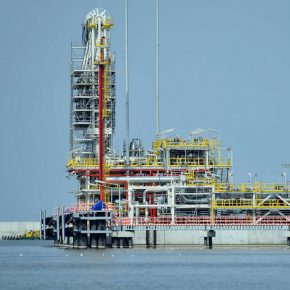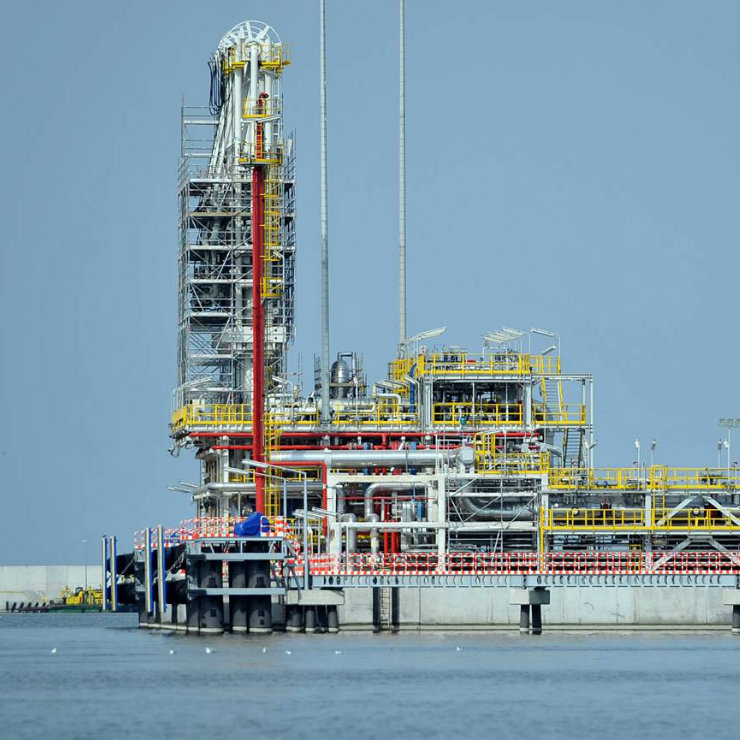Tydzień w gospodarce
Category: Trendy gospodarcze

LNG port in Świnoujście, Poland (©PAP)
Poland’s President Andrzej Duda, during his latest visit to the United States, stated in an address to cadets at the Military Academy of West Point that the future energy co-operation with the United States in gas supplies is a result of the Russian threat. He declared “Russia exploits its influence in the European energy sector for the purposes of political manipulation, which is why one of our most important priorities is the diversification of our energy sources. We hope for further development of co-operation in this area, since we plan to be the regional hub for American gas and as such form an alternative for the region,” he said.
Poland has a twin pillar strategy to realise the above goal: development of the LNG (Liquefied Natural Gas) terminal at the north-western coastal terminal of Świnoujście , and to proceed with Baltic Pipe (the pipeline from the Norwegian gas fields). Two recent announcements highlight the progress made. It can be argued that there is a third pillar to this policy; stop Nord Stream 2.
Gaz-System S.A., the Polish state-owned pipeline operator, has decided to develop the maritime area of the LNG terminal at Świnoujście. Polish media reported that it plans to build a second quay by 2021 which will enable the bunkering of LNG and transfer to smaller ships for onward transport to Baltic destinations. This sector could work independently of the existing terminal in the handling of bulk carriers.
The LNG would be off-loaded and sent to Nynashamm, or the planned Lysekil terminal in Göteborg, Sweden. Finland is due to complete its Tornio-Manga terminal. Estonia is planning its LNG terminal and Lithuania’s Klaipeda terminal is up and running. The latter is a medium capacity plant and Gaz-System plans large capacity handling.
The other pillar of Polish policy, the Baltic Pipe, inches forward with the agreement for the preparatory work signed at the beginning of August. The contract to undertake the analyses, research and initial design work was signed by Gaz-System and Danish engineers Rambøll Danmark A/S. The work will comprise the necessary geophysical, geo-technical and environmental research to get permission for eventual construction.
Tomasz Stępień, Chairman of Gaz-System said “We are time-sensitive and rely on the thorough completion of the submarine gas pipeline. We hope that the work we’ve done up to now as well as the experience of our contractor will contribute to the success of the entire project. In August, the first geophysical and environmental work will begin in the Baltic Sea. They will enable us to settle the exact path of the pipeline.”
The gas pipeline will link the Norwegian gas fields of the North Sea shelf and proceed to the Baltic and Poland via Denmark. It will also have a reconnection capacity that will enable gas to be channelled to Sweden and Denmark. It will receive via the Norwegian-Danish link on the West coast of Denmark , gas from the North Sea, transport it via an upgraded Danish overland link to a plant in Zealand on the east coast where it will be liquefied, thence to Świnoujście via the submarine interconnector. From Poland it will be transported by the developed Polish system southwards to Poland and the countries of the ‘Three Seas Initiative,’ the fledgling north-south axis of Eastern European states (Czech Republic, Slovakia, Hungary and through to the Adria LNG terminal in Croatia).
According to Gaz-System’s website the mission will make a “significant contribution to the creation of an internal European energy market. The project is aligned with the objectives of the EU’s energy policy, such as increased competition, integration of gas markets improved security of supplies and effective implementation of sustainable development guidelines.”
Much of the project, one that will include interconnectors and inter-system connectors, is still in the planning stage but the aims are to increase the integration of regional gas markets, security of supply enable access to new sources of supply, for example Norwegian gas for Central and Eastern Europe
The TSO must publish a Gas Regional Investment Plan (GRIP) every two years. The Baltic Energy Market Interconnection Plan Group have just developed its first GRIP, that presents an overview of the challenges ahead and covers 2012-2021.
Jan Chadam, CEO of Gaz System said “The BEMIP GRIP is a great example of successful co-operation amongst gas TSOs that contributes to the integration of national gas markets into a single well interconnected gas market in the Baltic Sea Region…[the region] needs such co-operation which will bring to an end the existing “energy islands”, enhance security of supply and pave the way towards the completion of a diversified and competitive EU energy market.”
The TSOs involved in the project are regional; Estonia, EEsti Gaas; Denmark, Energunet.dk; Finland, Gasum; Latvia, Latvijas Gaze; Lithuania, Lietuvos Dujos; Sweden, Swedegas, and Gaz-System from Poland.
However, time is of the essence. The preparatory work has just got under way but, according to a critical article in the portal energetyka24.pl, the planners and builders will be working against a 2019 deadline – the date when a renewed contract with Gazprom for gas from the Yamal-Europe pipeline should be confirmed, with a three year period of notice. In short, the Baltic Pipe needs to be completed by 2022. After that date, the contract with Gazprom is binding and the point of Baltic Pipe becomes redundant. There is also the problem of a relative lack of interest (outside the Baltic region) in the project to join PGNiG. In the absence of global energy giants, such as Shell or Statoil (the latter is ready to supply the gas but not to enter the project as a shareholder), international market credibility could suffer, not to mention the profitability of the pipeline itself which at a capacity of 10 billion cubic meters (bcm) is modest, by comparison with Yamal-Europe’s 32.9 bcm per year.
Given the tight deadline, the development of Świnoujście and its second quay makes sense as a Polish ‘Plan B’, although it would be one at a much reduced capacity between 5-7 bcm per year.


